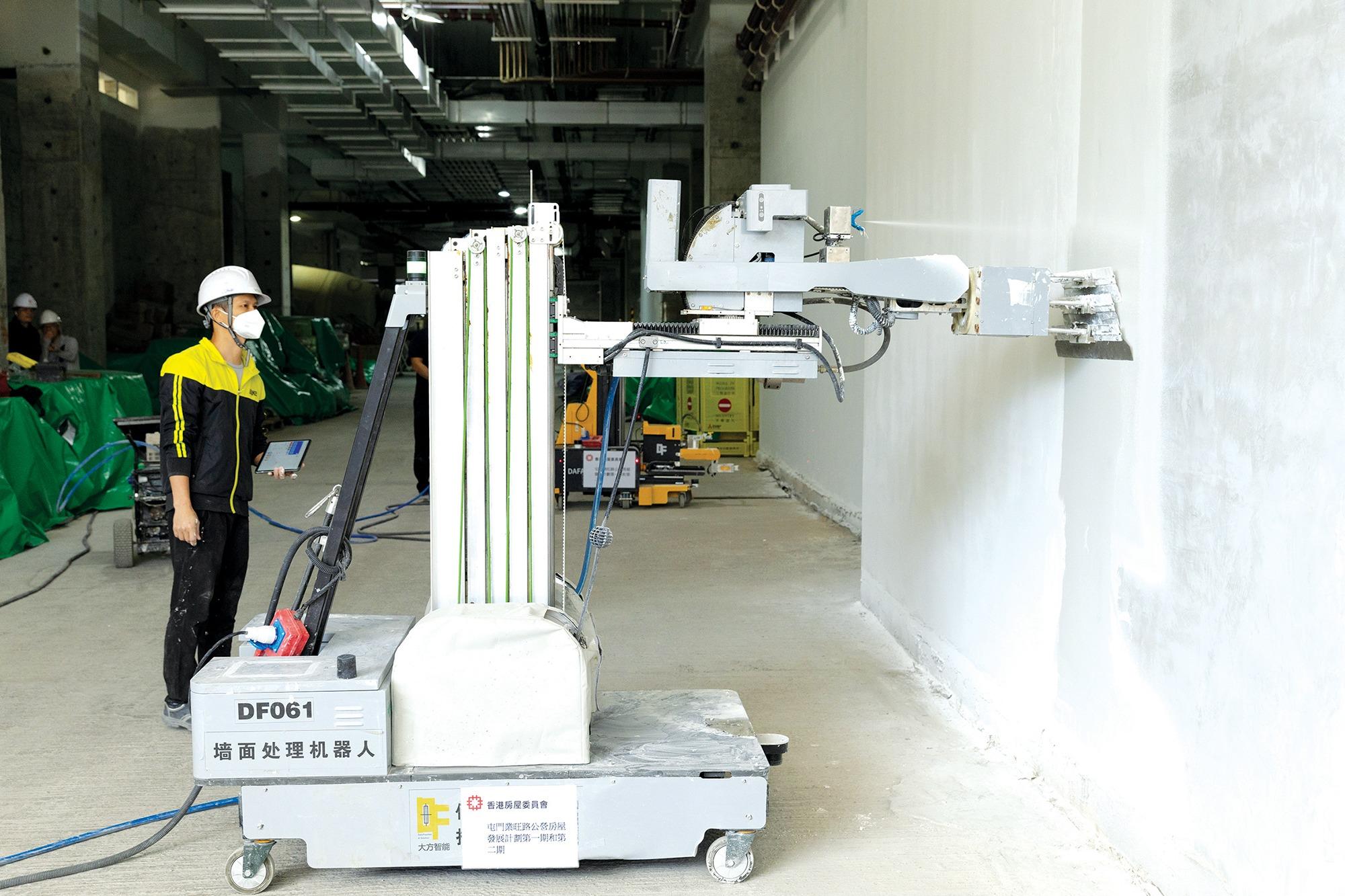 A worker operates the multifunctional robot DF061 at a public housing project in Tuen Mun, Hong Kong, on Nov 13, 2023. Introduced by the Hong Kong Housing Authority, the Chinese-mainland-produced robot is currently being used at four public housing projects in the city to increase productivity and minimize risks. (PHOTO PROVIDED TO CHINA DAILY)
A worker operates the multifunctional robot DF061 at a public housing project in Tuen Mun, Hong Kong, on Nov 13, 2023. Introduced by the Hong Kong Housing Authority, the Chinese-mainland-produced robot is currently being used at four public housing projects in the city to increase productivity and minimize risks. (PHOTO PROVIDED TO CHINA DAILY)
An indoor multifunctional construction robot has made its debut in a public housing project in Tuen Mun, performing plaster, polish, and spray work that reduces the construction time by about 10 percent while also ensuring the safety of workers.
The robot model DF061 is designed and manufactured by DaFang AI, a Chinese-mainland intelligent-construction robot service provider, and it was introduced to Hong Kong as the city’s construction industry acts to adopt innovative technologies.
Romeo Yiu Fan-hung, the Housing Department’s head of the Development and Construction InnoTech, said that the robot greatly improves construction efficiency by enabling a single operator to control multiple machines performing different tasks.
It also minimizes the risks associated with working at great heights, as the robot can be operated remotely from ground level during wall and ceiling work in high-rise buildings.
With a user-friendly design, workers require only simple training to master the robot’s control, which can be accessed on phone or tablet apps.
The construction robots come in different sizes to cater to various needs. For example, large robots are designed for tasks in parking lots, public transport interchanges and other high-floor locations, while smaller robots are assigned tasks within the public housing flats, carrying out wall and ceiling treatment via material conveyors.
As the city faces a shortage of workers and an aging population, the Housing Authority has included new rules on the use of construction robots in assessing tenders for new construction contracts since March 2020. So far, construction robots have been or will be employed on around 40 projects.
Yiu said that he hopes the use of robots and other inno-tech progress will enhance productivity and occupational safety and health and thus attract more young people to the industry.
Following the frequent construction site accidents, occupational safety and health have come under close scrutiny. For instance, four construction workers recently were injured — two seriously — by falling metal rods at a site on the Central Kowloon Route, and another construction worker was killed last week in an accident at the construction site of the Hospital Authority Supporting Services Centre in North Lantau.
Yiu added he hopes that through multiparty cooperation, the construction sector could speed up the construction work and increase its output, thereby alleviating the city’s housing supply shortage. In June, the yearly average waiting time for public rental housing was 5.3 years. And over the next decade, the demand for public housing is estimated to reach 308,000 units.
The Housing Bureau and the Hong Kong Applied Science and Technology Research Institute will sign a memorandum of understanding today to strengthen their collaboration on the research and application of innovative technologies in construction and property management.
DaFang AI, the construction robot’s developer, was established in Shenzhen in 2019 with a research-and-development center in Dongguan and a company in Hong Kong. The company has developed several products that integrated automatic driving and automated construction, holding applied for more than 121 patents, two Patent Cooperation Treaty patents, and nine software copyrights.
The mainland’s robotics industry has made great strides, with revenue surpassing 170 billion yuan ($23.3 billion) last year. The sector has received focused support from the national level after the State Council in 2015 launched “Made in China 2025”, which focused on upgrading the manufacturing industry and holding high expectations for its development.
Meanwhile, Hong Kong is also turning to robots as a solution to its aging population and labor shortage. During a visit to two robotics companies in Foshan, Guangdong province, in April, Hong Kong Chief Secretary for Administration Eric Chan Kwok-ki said the advanced technologies and mature experience of the mainland in developing and applying construction robots are helpful to Hong Kong, as the city steps up its efforts to implement large-scale infrastructure projects.


